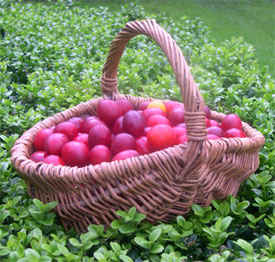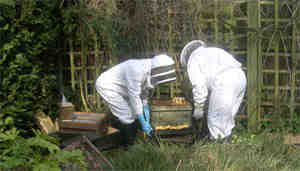Cottage Smallholder Plum Chutney or Damson Chutney
Posted by Fiona Nevile in Chutney and Pickles, Jam Jelly and Preserves | 222 comments
a wicker basket full of wild plums
This chutney recipe works well with plums, wild plums or damsons. It does not need months to mature and keeps well
I had some spare time today so finally retrieved the stock pot from Danny, swooshed it out with bicarbonate of soda to get rid of the taint of clove chutney (see Tricks and Tips below) and found the plum chutney recipe from Anne Mary’s old cook book. This was going to be the base of our own Cottage Smallholder Chutney.
I had collected three pounds of windfall wild plums yesterday and simmered them last night for 20 minutes in 75 ml of white wine vinegar. This is Delia’s canny trick to avoid stoning fresh plums for chutney (use some of the vinegar that you are going to use for your brew). This morning, grabbing a handful at a time, it was easy to find the stones and remove them (our wild plum stones are tiny, barely a centimetre long).
At breakfast we studied Anne Mary’s recipe and decided how we would change it to create a plum chutney that we would be proud of. Danny had to go to London so pinpointed his essential ingredients for our chutney – balsamic vinegar and juniper berries. As I was the one who ruined the last “Let’s make our own” batch with too many cloves, I decided that our chutney was definitely going to work this time.
There was a clove shaped crisis of confidence. And consequently the alterations that I made today were incrementally smalll. This meant hours of tasting, comparisons and retasting, until I felt quite queasy from ingesting so much chutney. (At least a jar without lunch). It has now simmered (tiny bubbles barely breaking the surface) for five hours. When you draw a wooden spoon through the chutney, it is thick enough to see where you have been. It is finally done, and approved for release. We have made a great plum chutney, extra fruity and piquant.
Danny returned exhausted from London and sniffed the aroma as he walked into the kitchen. There was a long silence as he grabbed a spoon and rushed to the stock pot for a taste. His response was positive. Our recipe is below..
Our latest Plum and Tamarind Chutney recipe is here.
Tricks and Tips:
- How do I get rid of tainted smells in pots?
If your cooking pot or container is tainted with the smell of the last resident (curry, tomato sauce etc). Sprinkle with a good tablespoon of bicarbonate of soda into it and add a good splosh of hot water. Rub the solution over all surfaces and leave for two minutes. Rinse well in cold water.
- How do I sterilise jars and lids?
The sterilising method that we use is simple. Just before making the jam, I quickly wash and rinse the jars and place them upside down in a cold oven. Set the temperature to 160c/140c for fan assisted. When the oven has reached the right temperature I turn off the heat. The jars will stay warm for quite a while. I only use plastic lined lids for preserves as the all-metal lids can go rusty. I boil these for five minutes in water to sterilise them. If I use Le Parfait jars, I do the same with the rubber rings.
| Cottage Smallholder Plum Chutney or Damson Chutney |
- 3lbs/1350g wild plums/damsons/eating plums
- 1lb/450g of apples (cored but not skinned). Chopped fine. Cooking apples are best but eating apples would do at a pinch.
- 1 lb/450g onions chopped fine
- 10.5 ozs/300g dried apricots (chopped at least into eight)
- 7 ozs/200g dried raisins (chopped into four)
- Half lb-1lb/225g-450g of soft brown sugar, depending on how sweet your wild plums/damsons/eating plums are. We’d usehalf a lb of sugar for eating plums but used 1lb for this batch as we were using wild plums (these are very tart like damsons).
- 2 large cloves of garlic chopped fine
- Half tsp of cayenne pepper
- 2 tsp of salt
- 1 tsp of allspice powder
- 1 tsp cinnamon powder
- 1 tsp ground ginger
- 1and a half pints/750 ml of white wine vinegar
- 1 small hot chilli
- 2 tsp of balsamic vinegar
- 5 juniper berries
- 10 black peppercorns
- Stone the plums and if big enough cut into slices.
- Chop the apples, onions, raisins and apricots.
- Place all ingredients in a large heavy bottomed saucepan and bring slowly to a gentle boil. Turn the heat down immediately and simmer very gently (tiny bubbles just breaking the surface on the lowest heat) for at least five hours until the mixture has broken down and thickens.
- Stir from time to time and more towards the end. If your simmering point is higher than ours, your chutney will be ready sooner. Take a peek every half hour or so. The chutney will thicken as it cools.
- When ready pour into sterilised jars and cover with plastic lined metal lids (how do I sterilise jars and lids? See Tips and Tricks above).
Leave a reply






Thanks again. I can’t wait to make this chutney this coming weekend.
My grandma taught me to always use a hot water bath on jams or chutneys but my housemate’s mom never uses one. As long as I heat the jars and make sure they’re sealed properly (center button down) when they’re cooled, can I skip the hot water bath for other chutneys and jams, too? Or does it depend on the recipe?
Thanks again for your help. I appreciate it!
Hi Anna
There no need to process the jars in a water bath after sealing as they will create their own vacuum as they cool down (just like jam).
Awesome. Thanks.
After I seal the jars, do I need to process them in a hot water bath or are they ok without it?
Thanks again!
Hi Anna
This recipe is really good.
You need to sterilise the jars and lids and pou the chutney into the warm jars and seal immediately.
i’ve got thirteen boxes of plums and another treeful in my garden. this recipe sounds fabulous. do i need to process the jars in a water bath like jam, or just seal them up?
Hi Rebecca
Yellow plums should be fine, I reckon. Thanks for giving the ammount the the recipe makes.
Hi Emily
You could make a great Mirabelle vodka. The ingredients should be similar to raspberry vodka https://www.cottagesmallholder.com/?p=362
Hi Ann
They are great stuffed inside a roast duck or a really succulent chicken.
The quince recipe sounds delicious.
Hello Cerys
I haven’t tried this recipe in the slow cooker. Why not Google slow cooker chutney recipes to get an idea of timings.
Hi Everyone
I would like to use my slow cooker to make the plum chutney.
Could anyone tell me how long to cook the chutney and whether I’d have to change the method.
cheers muchly!
I made 6 jars.
I actually used yellow plums……hopefully it will be ok. I’ll find out in 6 weeks!
Onion chutney today!
Aha, of all the plum trees in my garden (been in my house nearly a year) one small tree had late maturing, small yellow plums, dense flesh a bit tart, totally ignored by birds. Emily’s post triggered me to look up Mirabelles and I think that is what my ‘late’ plum is. Anyway I have a bag in the freezer so will be interested to see if you have any good ideas. Have ‘discovered’ quinces this year and just cooked up a super batch with lots of citrus peel, juice wine and star anise.
Hello everyone – have just been given a huge bag of yellow mirabelles. Does anyone have the faintest idea what to do with them?! Have already made a batch of plum chutney and would quite like to make either a chutney which would keep their colour (turmeric?) or a liqueur. Any thoughts or recipes would be appreciated!